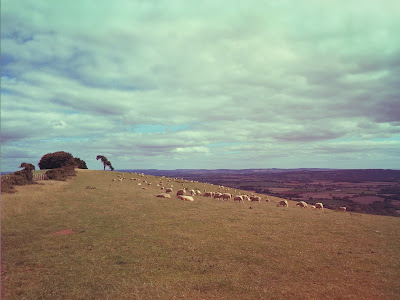Reading and walking "Raddon Top" whilst Donald Trump and Kim Jong-un talk up the possibility of nuclear war
 |
| Looking east towards the lone tree on Raddon Top |
I was very much involved in the CND revival of the early 1980s and on one occasion spent a week taking part in the ongoing blockade of the nuclear weapons factory at Burghfield. The fear that the weapons constructed at this and other sites would actually be used was at the time reasonable, real, and palpable and so I was concerned to do everything I could, not only to get the UK to abandon its own nuclear weapons but also to get the USA to move its weapons out of this country too. But since the end of the Cold War in 1991 (with the collapse of the Soviet Union) that fear, although it has never quite gone away, has slowly ebbed from the forefront of my consciousness. However, over the past week, perhaps not surprisingly, this fear has taken a few steps forward once more.
 |
| A lone walker arrives at the lone tree on Raddon Top |
As my words above reveal, Balfour-Paul also wrote poetry including one darkly ironic one called “Raddon Top.” Its relevance to my nuclear-war related thoughts will quickly become apparent. I took the photos in this post during this afternoon’s walk with my iPhone 6+ and the Hipstamatic and Blackie Apps. Just click on a photo to enlarge it.
Raddon Top
Up here where every eye-lash leads to another pheasant and
all four quarters of the compass are spread out to view,
a bronze-age ring, detected from the air, encircles
its smaller iron-age successor, inside which
are tell-tale tiles of a Roman temple and
in the very middle, underground, the
County Planning Committee's
nuclear bunker. No room
inside that for
anything
smaller.
When the
emergency
is over will a few
committee members crawl
out from the bunker to administer
a vanished population? Maybe the whole
process will start again with a bronze-age ring
raised with stone axe-heads round the hill-top and
ragged councillors using the feathers of all those dead
pheasants to start a fire will squat there to manufacture
rough pottery for boiling barely digestible grass-seeds in.
An alternative outcome is that the few starving survivors
will struggle down to the sea and new across
to America, for America will
assuredly have contrived
to escape the
emergency
scot-
free.
 |
| Looking north from Raddon Top |
 |
| Looking east up towards Raddon Top |


Comments